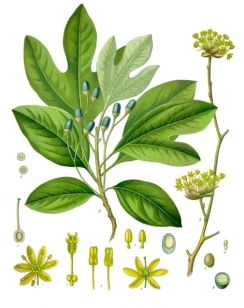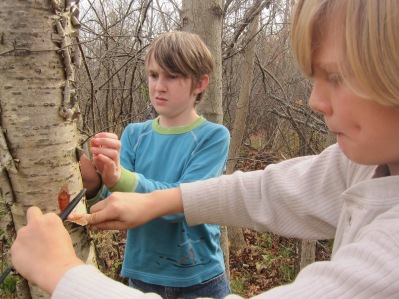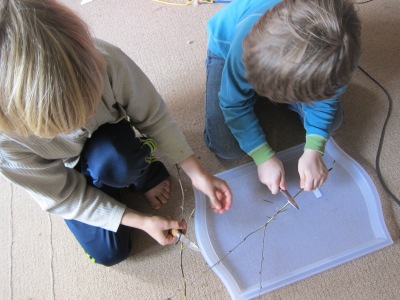
Sarsaparilla (Smilax ornata; top) was introduced to Europe in the 16th century by the Spaniards, first from Mexico and later from Honduras. Mexico, Central America and many parts of northern South America abound in various species of sarsaparilla, valued by the natives for their, more or less, medicinal qualities. The natives value its nourishing and healing qualities so much they would drive their cattle to areas where it grew in abundance in order to feed on the plants and receive its benefits.

Sassafras (Sassafras albidum; top) was a well-known plant to the natives of the southwestern United
States way before the Europeans came around. It had many purposes,
including cooking (to flavor bear fat, to cure meat) and medicinal. The
European interest in sassafras brought Europeans into closer contact
with the Native Americans during the early years of settlement in 16th and 17th
century Florida, Virginia and parts of the Northeast. Early European
settlers enjoyed the aromatic scent of sassafras – according to legend,
Christopher Columbus finally found land because he could smell the
sassafras! As early as the 1560s, French visitors to North America
discovered the medicinal qualities of sassafras, as well as the Spanish
who arrived in Florida.
Martin Pring; in his own words (1603):
“In all these places we found no people, but signes of fires where they had beene. Howbeit we beheld very goodly Groves and Woods replenished with tall Okes, Beeches, Pine-trees, Firre-trees, Hasels, Wich-hasels and Maples. We saw here also sundry sorts of Beasts, as Stags, Deere, Beares, Wolves, Foxes, Lusernes, and Dogges with sharpe noses. But meeting with no Sassafras, we left these places with all the foresaid Ilands, shaping our course for Savage Rocke discovered the yeere before by Captaine Gosnold, where going upon the Mayne we found people, with whom we had no long conversation, because here also we could find no Sassafras. De-parting hence 3 we bare into that great Gulfe which Captaine Gosnold over-shot the yeere before, coasting and finding people on the North side thereof. […] Bancroft, following Belknap, identifies Whitson’s Bay with the harbor of Edgartown, Martha’s Vineyard, which is in the latitude of 41° 25g. […]and finding a pleasant Hill thereunto adjoyning, we called it Mount Aldworth, for Master Robert Aldworths sake a chiefe furtherer of the Voyage, as well with his Purse as with his travell. Here we had sufficient quantitie of Sassafras.”
Is root beer period plausible?
What this rather long introduction means is that both main root beer flavors – sarsaparilla and sassafras – were known in 16th century Europe, and at least sassafras was used in a drinkable medicinal concoction in Europe. Unfortunately, it was not (yet) fermented… The tradition of brewing, or fermenting, root beer is thought to have evolved out of other European small beer traditions that produced fermented drinks with very low alcohol content. These were thought to be healthier to drink than possibly tainted local sources of drinking water, and enhanced by the medicinal and nutritional qualities of the ingredients used. For instance, the 14th century recipe Tizanne Doulce (like a tisane, or infusion) uses barley, licorice root and crystal sugar to make a root beer-like beverage.Le Ménagier de Paris, 1393
TIZANNE DOULCE. Take water and boil
it, then for each sester [the sester of 8 pints] of water put in a bowl
heaped with barley, and it matters not if it be hulls and all, and two
parisis [2 1/2d.] worth of liquorice, item, figs, and let it be boiled
till the barley bursts; then let it be strained through two or three
pieces of linen, and in each goblet put great plenty of crystallised
sugar. Then the barley is good to give to poultry to eat to fatten them.
Note that the good liquorice is the newest and it is a fresh greenish
colour, and the old is more faded and dead and is dry.
Roots, bark, resin, fruits & flowers
We chose these specific roots, barks and leaves as these either grew in the back yard (our property adjoins a New York State Protected Wetland, so plenty of bio-diversity) or we already had in the kitchen cupboards. Even though I met someone via Facebook who lived in the South and had a sassafras tree in his backyard and was willing to ship rootstock, unfortunately, facebook ate the conversation and he was never heard from again… so this time around, at least, no period-correct Southern grown sassafras. We substituted with black birch, as that has a root beer typical wintergreen-like flavor, and spicebush (bottom).

Backyard scavenger hunt with friend.
Our recipe
- 0.6 oz black birch bark
- 0.6 oz spicebush bark
- 0.3 oz licorice root
- 0.3 oz dandelion root
- 0.3 oz birch bark
- 0.3 oz black cherry bark (included resin)
- 0.3 oz juniper berries
- 1 tbs hops flowers
- 1 tbs ginger root
- 1 cinnamon stick
- 2 ½ quart water
- 1 cup sugar (brown sugar)
- yeast starter (ale yeast, reclaimed from a perry).


The next day, he poured some reclaimed ale yeast into a 1 gallon carboy, and poured the infusion – through a filter – into the same carboy. He added 1 cup of sugar, for the yeast. He then shook the carboy well to dissolve all the sugar, and carefully poured the infusion into his recycled fliptop soda bottles. They were left in a warm place to start fermentation. They will stay out for a few days, until carbonation is visible, and then be refrigerated to stop/slow down the yeast.
A table showing the different botanicals that can be used in root-beer (X marks the ones we used):
| Roots and herbs | Spices | ||
| Sassafras albidum – roots, leaves, bark | Pimenta dioica – allspice | ||
| Smilax ornata –sarsaparilla | X | Juniperus communis – juniper berries | |
| Smilax glyciphylla – sweet sarsaparilla | Trigonella foenum-graecum – fenugreek | ||
| Piper auritum – root beer plant | Myroxylon balsamum – Tolu balsam | ||
| X | Glycyrrhiza glabra – liquorice (root) | Abies balsamea – balsam fir | |
| Aralia nudicaulis – wild sarsaparilla | Myristica fragrans – nutmeg | ||
| Gaultheria procumbens – wintergreen (leaves and berries) | X | Cinnamomum verum – cinnamon (bark) | |
| X | Betula lenta – sweet birch (sap/syraup/resin) | Cinnamomum aromaticum – cassia (bark) | |
| X | Betula nigra – black birch (sap/syrup/resin) | Syzygium aromaticum – clove | |
| X | Prunus serotina – black cherry | Foeniculum vulgare – fennel (seed) | |
| Picea rubens – red spruce | X | Zingiber officinale – ginger (stem/rhizome) | |
| Picea mariana – black spruce | Illicium verum – star anise | ||
| Picea sitchensis – Sitka spruce | Pimpinella anisum – anise | ||
| Arctium lappa – burdock (root) | X | Humulus lupulus – hops (bells/flowers) | |
| X | Taraxacum officinale – dandelion (root) | Mentha species – mint | |
| Other ingredients | |||
| Hordeum vulgare – barley (malted) | |||
| Hypericum perforatum – St. John's wort | |||
| X | Sugar | ||
| Molasses | |||
| X | Yeast |
Note: black birch and the evergreen Gaultheria are both sources for the scent wintergreen.
Note: while in medieval European brewing Juniperus communis was used, as we have several mature trees of Juniperus virginiana we used that instead. Like its European counterpart, Virginian juniper is also used to flavor gin.
Medieval European plausibility of our chosen ingredients: [yes / no]
| black birch bark | wh | eastern North America | no |
| spicebush bark | wh | eastern North America | no |
| dandelion root | wh | native to Eurasia and North America | yes |
| birch bark | wh | native to Eurasia and North America | yes |
| black cherry bark | wh | eastern North America, Central America | no |
| juniper berries | hg | native to Eurasia and North America | yes |
| hops flowers | hg | introduced to northern Europe in the 9th century | yes |
| licorice root | cs | native to southern Europe and parts of Asia | yes |
| ginger root | cs | exported to EU via India in the first century AD | yes |
| cinnamon stick | cs | exported to EU via Africa (Egypt) from Sri Lanka | yes |
Legenda – wh: wild harvested; hg: home grown; cs: commercially sourced
Observations
- this is an excellent youth-adult project!
- neither of us liked the licorice after-taste.
- next time we intend to add burdock, and maybe some mint, or anise – the possibilities are endless!
- only add a little bit of lees. There is plenty of yeast in even a little bit to start fermentation.
- if using commercial dry (bread) yeast, a pinch to each bottle is enough.
- as soon as vigorous carbonation is visible on the outside of the bottles, put them in the fridge.
- just in case, have a large container ready when opening the flip-top to catch any overly-carbonated blow-out.
- fermented root beer will go alcoholic eventually – keep an eye on the brew so the kids don’t get too frisky.
- alcoholic root beer tastes quite good!
And as Sir Kenelme Digby so aptly advised, in his slightly post-period brewing cornucopia:
“You may use what Herbs or Roots you please, either for their tast or vertue…”
Sources
- Cummings, Kate. Sassafras Tea: Using a Traditional Method of Preparation to Reduce the Carcinogenic Compound Safrole. All Theses 1345, 2012. https://tigerprints.clemson.edu/all_theses/1345
- Dietz, Birgit and Judy L. Bolton. Botanical Dietary Supplements Gone Bad. Chem Res Toxicol. 2007 Apr; 20(4): 586–590. https://www.ncbi.nlm.nih.gov/pmc/articles/PMC2504026/
- Gibbons, T. G. Sarsaprilla; a short account of its introduction into Europe; … its medical virtues, etc. 1871 (p. 3) https://books.google.com/books?id=c8QN2oaqyy0C&dq=introduction+of+saraspirilla+into+europe+from+mexico&source=gbs_navlinks_s
- Pring, Martin, 1580-1646. The Voyage of Martin Pring, 1603. Burrage, Henry S. (editor). Early English and French Voyages, Chiefly from Hakluyt, 1534-1608. (New York: Charles Scribner’s Sons, 1906). Pages 343-352 (p. 346-47). http://content.wisconsinhistory.org/cdm/ref/collection/aj/id/2523
- The recipe is altered from http://nourishedkitchen.com/homemade-root-beer-recipe/
- https://en.wikipedia.org/wiki/Root_beer
- https://en.wikipedia.org/wiki/Saloop
- https://en.wikipedia.org/wiki/Sassafras_albidum
- Image of sassafras from: https://commons.wikimedia.org/wiki/File:Sassafras_albidum_-_K%C3%B6hler%E2%80%93s_Medizinal-Pflanzen-260.jpg
- Image of spicebush from: https://www.pinterest.com/pin/568790627910099291/
- Image of sarsaparilla: A Flora of the State of New York by John Torrey Vol. 1. Albany, NY: Carroll and Cook Printers, 1843.
I was a little surprised you couldn't find sassafras - I remember it being a common understory tree in the forests of NJ where I grew up. Quite a distinctive smell!
ReplyDeleteIt wasn't until I looked at the range map that it made sense (https://en.wikipedia.org/wiki/Sassafras_albidum#/media/File:Sassafras_albidum_range_map.jpg) - I guess you're just a little too far north!
I was surprised too! Same with sarsaparilla, and Marsh Rosemary :) I have not seen sarsaparilla here in the Finger Lakes at all - but - when we were in the ADK last summer, at this off the grid little bog park, there it was... and a whole bunch of them. It was labeled as an unusual plant. I will keeping my eyes open tho, who knows, they might show up somewhere completely unexpected!
DeleteI often use this Cornell Plantations Plant Finder, and if they do not have it, it is either widely common, or not common at all...
ReplyDeletehttp://www.cornellbotanicgardens.org/findaplant/search?search=